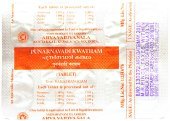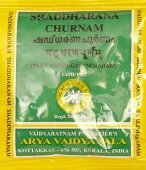Darvi, Dārvī: 18 definitions
Introduction:
Darvi means something in Hinduism, Sanskrit, biology. If you want to know the exact meaning, history, etymology or English translation of this term then check out the descriptions on this page. Add your comment or reference to a book if you want to contribute to this summary article.
In Hinduism
Ayurveda (science of life)
Cikitsa (natural therapy and treatment for medical conditions)
Source: Wisdom Library: Ayurveda: CikitsaDārvī (दार्वी):—A Sanskrit word referring to “Indian barberry” and is used throughout Ayurvedic literature such as the Caraka-saṃhitā. Its official botanical name is Berberis aristata and it is commonly referred to in English as “Indian Barberry” or “Tree Turmeric”. It is native to the Himalayas, but other species of the genus are found throughout the temperate and sub-tropical regions of Asia.
This plant (Dārvī) is also mentioned as a medicine used for the treatment of all major fevers, as described in the Jvaracikitsā (or “the treatment of fever”) which forms the first chapter of the Sanskrit work called Mādhavacikitsā. In this work, the plant has the synonym Dāru.
Source: Ancient Science of Life: Botanical identification of plants described in Mādhava CikitsāDārvī (दार्वी) or Rasāñjana refers to the medicinal plant Berberis aristata DC., and is used in the treatment of atisāra (diarrhoea), according to the 7th century Mādhavacikitsā chapter 2. Atisāra refers to a condition where there are three or more loose or liquid stools (bowel movements) per day or more stool than normal. The second chapter of the Mādhavacikitsā explains several preparations [including Dārvī] through 60 Sanskrit verses about treating this problem.
The plant Berberis aristata DC. (Dārvī, Rasāñjana) is also known as Dāruharidrā according to both the Ayurvedic Formulary and the Ayurvedic Pharmacopoeia of India.
Kalpa (Formulas, Drug prescriptions and other Medicinal preparations)
Source: Shodhganga: Edition translation and critical study of yogasarasamgrahaDārvī (दार्वी) refers to the medicinal plant known as “Coscinium fenestratum (Gaertn.) Colebr.” and is dealt with in the 15th-century Yogasārasaṅgraha (Yogasara-saṅgraha) by Vāsudeva: an unpublished Keralite work representing an Ayurvedic compendium of medicinal recipes. The Yogasārasaṃgraha [mentioning dārvī] deals with entire recipes in the route of administration, and thus deals with the knowledge of pharmacy (bhaiṣajya-kalpanā) which is a branch of pharmacology (dravyaguṇa).

Āyurveda (आयुर्वेद, ayurveda) is a branch of Indian science dealing with medicine, herbalism, taxology, anatomy, surgery, alchemy and related topics. Traditional practice of Āyurveda in ancient India dates back to at least the first millenium BC. Literature is commonly written in Sanskrit using various poetic metres.
Purana and Itihasa (epic history)
Source: archive.org: Puranic EncyclopediaDārvī (दार्वी).—An ancient town in India. (Mahābhārata Bhīṣma Parva, Chapter 9, Verse 54).

The Purana (पुराण, purāṇas) refers to Sanskrit literature preserving ancient India’s vast cultural history, including historical legends, religious ceremonies, various arts and sciences. The eighteen mahapuranas total over 400,000 shlokas (metrical couplets) and date to at least several centuries BCE.
Yoga (school of philosophy)
Source: ORA: Amanaska (king of all yogas): A Critical Edition and Annotated Translation by Jason BirchDarvī (दर्वी) refers to the “ladle” (used for eating food), according to the Amanaska Yoga treatise dealing with meditation, absorption, yogic powers and liberation.—Accordingly, as Īśvara says to Vāmadeva: “[...] Those said to be learned in comprehending the teachings of [the fourteen branches of Brahmanical] learning, [but] do not know the highest reality of the self, are just like the ladle (darvī) [which does not know] the taste of cooked food. [...]”.

Yoga is originally considered a branch of Hindu philosophy (astika), but both ancient and modern Yoga combine the physical, mental and spiritual. Yoga teaches various physical techniques also known as āsanas (postures), used for various purposes (eg., meditation, contemplation, relaxation).
General definition (in Hinduism)
Source: archive.org: Vedic index of Names and SubjectsDarvi (दर्वि), or Darvī (दर्वी), properly denotes a ‘ ladle,’ in which sense it is found in the Rigveda and later. But the word also means a serpent’s ‘hood’ in the Atharvaveda, though Zimmer regards it as the name of a serpent.
Biology (plants and animals)
Source: Wisdom Library: Local Names of Plants and DrugsDarvi in the Sanskrit language is the name of a plant identified with Berberis aristata DC. from the Berberidaceae (Barberry) family having the following synonyms: Berberis coccinea, Berberis macrophylla. For the possible medicinal usage of darvi, you can check this page for potential sources and references, although be aware that any some or none of the side-effects may not be mentioned here, wether they be harmful or beneficial to health.
Source: Google Books: CRC World Dictionary (Regional names)1) Darvi in India is the name of a plant defined with Berberis aristata in various botanical sources. This page contains potential references in Ayurveda, modern medicine, and other folk traditions or local practices It has the synonym Berberis aristata Sims.
2) Darvi is also identified with Berberis asiatica It has the synonym Berberis asiatica Roxb. ex DC. (etc.).
3) Darvi is also identified with Coscinium fenestratum It has the synonym Menispermum fenestratum Gaertn. (etc.).
4) Darvi is also identified with Elephantopus mollis It has the synonym Asterocephalus cochinchinensis Spreng. (etc.).
Example references for further research on medicinal uses or toxicity (see latin names for full list):
· Journal of Botany (1939)
· Journal of Ethnopharmacology (1992)
· Primitiae Florae Essequeboensis (1818)
· Newslett. Int. Organ. Pl. Biosyst. (Oslo) (1997)
· Journal of Cytology and Genetics (1984)
· American Journal of Chinese Medicine (1991)
If you are looking for specific details regarding Darvi, for example chemical composition, extract dosage, diet and recipes, pregnancy safety, side effects, health benefits, have a look at these references.

This sections includes definitions from the five kingdoms of living things: Animals, Plants, Fungi, Protists and Monera. It will include both the official binomial nomenclature (scientific names usually in Latin) as well as regional spellings and variants.
Languages of India and abroad
Sanskrit dictionary
Source: DDSA: The practical Sanskrit-English dictionaryDarvī (दर्वी) or Darvi (दर्वि).—f. [dṝ-vin vā ṅīp]
1) A ladle, spoon.
2) The expanded hood of a snake; पृथुदर्विभृतस्ततः फणीन्द्रा (pṛthudarvibhṛtastataḥ phaṇīndrā) Śiśupālavadha 2.42.
Derivable forms: , darviḥ (दर्विः).
--- OR ---
Dārvī (दार्वी).—f.
1) A ladle.
2) a kind of turmeric.
3) A kind of tree (Mar. dāruhaḷada); दार्वी तु देवदारुहरिद्रयोः स्रुचि दारु- हरिद्रायाम् (dārvī tu devadāruharidrayoḥ sruci dāru- haridrāyām)......Nm.
Source: Cologne Digital Sanskrit Dictionaries: Shabda-Sagara Sanskrit-English DictionaryDārvī (दार्वी) or Dārvvī.—f. (-rvī) 1. A sort of Curcuma, (C. zanthorrhizon.) 2. A kind of pine: see devadāru. 3. Turmeric. 4. Gojihwa, a potherb. 5. A collyrium extracted from an infusion of the Curcuma zanthorrhizon. E. dṝ to tear or dissipate (disease,) uṇ affix fem. affix ṅīṣḥ see dāru .
Source: Cologne Digital Sanskrit Dictionaries: Benfey Sanskrit-English DictionaryDarvi (दर्वि).—darvī, i. e. dṛ10 + vī, 1. A spoon, Mahābhārata 2, 1945. 2. The expanded hood of a snake (see the next). 3. The name of a country, Mahābhārata 6, 362.
Darvi can also be spelled as Darvī (दर्वी).
Source: Cologne Digital Sanskrit Dictionaries: Cappeller Sanskrit-English DictionaryDarvi (दर्वि).—[feminine] the same; the hood of a snake.
--- OR ---
Darvī (दर्वी).—[feminine] the same; the hood of a snake.
Source: Cologne Digital Sanskrit Dictionaries: Monier-Williams Sanskrit-English Dictionary1) Darvi (दर्वि):—[from darma] f. ‘wooden (cf. dru)’, a ladle, [Ṛg-veda v, x; Atharva-veda] ([vocative case] ve, [iii, 10, 7]; cf. [Pāṇini 7-3, 109], [vArttika] 2, [Patañjali])
2) [v.s. ...] the hood of a snake (cf. vi-darvya), [Atharva-veda x, 4, 13]
3) [v.s. ...] m. Name of a son of Uśīnara, [Viṣṇu-purāṇa iv, 18, 1] ([varia lectio] va).
4) Darvī (दर्वी):—[from darma] f. = vi, a ladle, [Vājasaneyi-saṃhitā ii, 49] ([vocative case] vi; cf. [Pāṇini 7-3, 109; Vārtt. 2]), [Kauśika-sūtra; Āśvalāyana-gṛhya-sūtra; Pāraskara-gṛhya-sūtra; Gobhila-śrāddha-kalpa; Mahābhārata] etc.
5) [v.s. ...] the hood of a snake, [cf. Lexicographers, esp. such as amarasiṃha, halāyudha, hemacandra, etc.]
6) [v.s. ...] Name of a country, [vi, 362].
7) Dārvī (दार्वी):—[from dārva > dāru] f. Curcuma Aromatica or Xanthorrhiza, also a kind of collyrium extracted from it, [Suśruta]
8) [v.s. ...] = deva-dāru, [cf. Lexicographers, esp. such as amarasiṃha, halāyudha, hemacandra, etc.]
9) [v.s. ...] = go-jihvikā, [cf. Lexicographers, esp. such as amarasiṃha, halāyudha, hemacandra, etc.]
Source: Cologne Digital Sanskrit Dictionaries: Yates Sanskrit-English DictionaryDārvī (दार्वी):—(rvvī) 3. f. A sort of curcuma; of pine; of potherb; of collyrium; of turmeric.
Source: DDSA: Paia-sadda-mahannavo; a comprehensive Prakrit Hindi dictionary (S)Darvī (दर्वी) in the Sanskrit language is related to the Prakrit word: Davvī.
[Sanskrit to German]
Sanskrit, also spelled संस्कृतम् (saṃskṛtam), is an ancient language of India commonly seen as the grandmother of the Indo-European language family (even English!). Closely allied with Prakrit and Pali, Sanskrit is more exhaustive in both grammar and terms and has the most extensive collection of literature in the world, greatly surpassing its sister-languages Greek and Latin.
Kannada-English dictionary
Source: Alar: Kannada-English corpusDarvi (ದರ್ವಿ):—
1) [noun] a long-handled utensil with a cup-shaped bowl for serving for stirring liquids.
2) [noun] a wooden spoon with long hand used in religious sacrifices for pouring the clarified butter into the sacrificial fire.
3) [noun] the expanded skin near the head of an excited cobra; the hood.
4) [noun] (fig.) a person used by another as a means in bringing something about.
--- OR ---
Dārvi (ದಾರ್ವಿ):—[noun] the tree Morinda citrifolia of Rubiaceae family; turmeric timber tree.
Kannada is a Dravidian language (as opposed to the Indo-European language family) mainly spoken in the southwestern region of India.
See also (Relevant definitions)
Starts with (+9): Darvibhrit, Darvida, Darvihaumika, Darvihoma, Darvihomika, Darvihomin, Darvika, Darvikara, Darvikari, Darvikarman, Darvikayantra, Darvike, Darvikvathodbhava, Darvina, Darvinavaad, Darvinavada, Darvindhana, Darvipatra, Darvipatrika, Darvipattrika.
Ends with: Ayodarvi, Budadadarvi, Homadarvi, Madarvi, Sarpadarvi.
Full-text (+25): Darvihoma, Darvika, Darvikara, Darvipatrika, Darbbi, Darvya, Darvikvathodbhava, Vidarvya, Purnadarva, Darvihomin, Darvibhrit, Rasanjana, Daruharidra, Darvipralepa, Darvisamkramana, Darvihomika, Ayodarvi, Darupita, Darunisha, Khaja.
Relevant text
Search found 37 books and stories containing Darvi, Dārvī, Darvī, Dārvi; (plurals include: Darvis, Dārvīs, Darvīs, Dārvis). You can also click to the full overview containing English textual excerpts. Below are direct links for the most relevant articles:
Rig Veda (translation and commentary) (by H. H. Wilson)
Parama Samhita (English translation) (by Krishnaswami Aiyangar)
Paraskara-grihya-sutra (by Hermann Oldenberg)
Sushruta Samhita, Volume 5: Kalpasthana (by Kaviraj Kunja Lal Bhishagratna)
Chapter IV - Description of the poison of a snakebite
Chapter V - The medical treatment of snake bites
Amarakoshodghatana of Kshirasvamin (study) (by A. Yamuna Devi)
Flora (8): Herbs < [Chapter 5 - Aspects of Nature]
Daily Life (4): Household Articles < [Chapter 3 - Social Aspects]
The Sacrifices of Rajasuya, Vajapeya and Ashvamedha (study) (by Aparna Dhar)
Pakṛti and Vikṛti Yāga < [Chapter 2 - Vedic Sacrifices described in the Śatapatha Brāhmaṇa]
Details of the Cāturmāsya Sacrifice < [Chapter 5 - Minor sacrifices and their Political Significance]
Related products
(+16 more products available)





